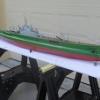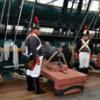-
Posts
1,171 -
Joined
-
Last visited
Reputation Activity
-
 jud reacted to mtaylor in cat davit's How where they used around 1535 on English ships
jud reacted to mtaylor in cat davit's How where they used around 1535 on English ships
Those look like catheads to me. Maybe that's what they are?
-
 jud reacted to BANYAN in HMB Endeavour tiller and steering question
jud reacted to BANYAN in HMB Endeavour tiller and steering question
Hi Dashi. Another interpretation of that wording "for the want of which the Tiller..." could also imply that a transom had not been formally fitted to Endeavour in the 1768 refit and that he was now fitting one (running improvement so to speak) as a result of the constant tiller issues; and this improvement was then formally amended into the plans of 1771?
cheers
Pat
-
 jud got a reaction from mtaylor in HMB Endeavour tiller and steering question
jud got a reaction from mtaylor in HMB Endeavour tiller and steering question
Glad you found some documentation for tiller support. In spite of the physic of an unsupported tiller being subject to failure, the supporting arc was a hard sell to most.
good job! :)
jud
-
 jud got a reaction from dashi in HMB Endeavour tiller and steering question
jud got a reaction from dashi in HMB Endeavour tiller and steering question
Glad you found some documentation for tiller support. In spite of the physic of an unsupported tiller being subject to failure, the supporting arc was a hard sell to most.
good job! :)
jud
-
 jud reacted to dashi in HMB Endeavour tiller and steering question
jud reacted to dashi in HMB Endeavour tiller and steering question
From the entry for Saturday 27th January from the book, 'First Voyage Around the World: Captain Cook's Journal During his First Voyage, Page 272, Cook writes:
"Saturday, 27th. Fresh gales, Westerly. This day we got the Tiller properly secured, which hath been the Employment of the Armourers and part of the Carpenters since we Anchor'd at this place; the former in repairing and making new Iron work, and the Latter in fixing a Transom,* for the want of which the Tiller has often been in danger of being broke; the Iron braces that supply'd the want of a Transom have broke every time they have been repair'd."
*The reference at the bottom of page 272 is indicating in this context Cook is saying: * A transom is a curved piece of wood which supports the end of the tiller.
Note: As has been pointed out later in this discussion this is not the generally accepted use of the word 'transom', which leaves this entry open to interpretation. It is my understanding that in earlier vessels such as carracks where the tiller passed out a hole in the stern, that the transom which passed under the tiller was reffered to as a tiller transom.https://books.google.co.nz/books?id=QU40AQAAMAAJ&pg=PA244&lpg=PA244&dq=tiller+transom+definition&source=bl&ots=qs6UGheA-I&sig=u-x5Oq0-HxISibbwwICUKXlkS18&hl=en&sa=X&ved=0ahUKEwirnaKZz6DNAhWHspQKHTNTAZUQ6AEIJzAG#v=onepage&q=tiller%20transom%20definition&f=false
My opinion based on the evidence to hand is that in this context the anotation is using the term 'transom' to mean a transverse timber support which passes under the tiller to support it's weight along it's sweep to replace the job of the iron tiller braces that kept breaking. But not having the carpenters log then this is just my best guess and we may never know for sure. I hope we can agree that Cook wouldn't have sailed with out ensuring the 'fix' to the tiller support 'defect' that took place over 12 days in Queen Charlotte's Sound New Zealand among other running maintenance repairs and de-fouling was up to the job and going to last the long voyage through uncharted waters that was still ahead.
https://books.google.co.nz/books?id=WT4zDAAAQBAJ&lpg=PA272&dq=endeavour%20tiller%20transom&pg=PA272#v=onepage&q=endeavour%20tiller%20transom&f=false
Cheers
-
 jud reacted to DavePete in inexpensive metal tray for a magnetic jig
jud reacted to DavePete in inexpensive metal tray for a magnetic jig
Many of you know that there is a magnetic building jig with magnets and a small flat steel tray to hold the magnets you can purchase for about $30.00... If you want inexpensive or larger consider an older discarded PC. Many have a flat steel removable side access panels that would be about 14" X 14" +/- and a lot less expensive than you can buy online. You can pick up magnets for about $11
If you haven't used magnets to hold things in place they are very handy and well worth the money.
-
 jud reacted to dashi in HM Bark Endeavour by dashi - Caldercraft - scale 1:64 - 1768-71 - bashed kit
jud reacted to dashi in HM Bark Endeavour by dashi - Caldercraft - scale 1:64 - 1768-71 - bashed kit
Stern facia:
Thought it would be easier to do the facia with the hull upside down so decided I needed to get this done before those bulwark cappings. I'm putting them off for as long as possible to give my brain a chance to work out the best approach for the retro-fit which I think I might now have.
Although a friend and I really liked the all blue facia, I must confess to a moment of dread after I first painted it all blue. Plus I'd glued the upper window ledge along the wrong side of my pencil marks making it too tight for the lids, so after seeing that water colour by Sydney Parkinson with the blue taffrail with what looks to be natural beneath and going by the only draught of the stern I have found which does not have the upper window ledge I decided a slight retro-makeover was needed.
Holding my breath I dived in and after a couple of days had removed the upper ledge and sanded off the paint. I then applied my pigmented stain and am happy with the result. One rooky mistake I made was to fit the windows before drilling the holes for the window lid hinges because some of the fine sawdust stuck itself to the inside of the glass, not that it's too noticeable.The window lids were also stained with the same pigmented stain and are dry fitted so can be put aside until much later.
-
 jud reacted to sephirem in Knot Tieing
jud reacted to sephirem in Knot Tieing
Thanks everyone for the replies, and information provided. I've gotten some rope and been practicing different knots so helpful to learn what I need to start with and then to learn about later.
-
 jud got a reaction from Canute in 131 year old iron hulled ship Wavertree being restored
jud got a reaction from Canute in 131 year old iron hulled ship Wavertree being restored
That photo inside the hull looks a lot like the inside of the hull of the Star of India the first time I was allowed in there, collision bulkhead was in place and the rest empty except for the Iron fresh water tank hanging from the overhead. The Star had a lot more rust and trash in there then, which was later cleaned out. My experience being in compartmentalized ships at that time, the open hull seemed huge as did the inner hull of a lumber schooner I was aboard in San Francisco. I like to see these of vessels restored, those with first hand memory's of the old folks talking about these ships are now gone, the only thing left of an era are the bones and some items like the old cheese safe we have in the family that arrived on the West coast aboard a Bark that had went around the Horn, it still smells of cheese.
jud
-
 jud reacted to dashi in HM Bark Endeavour by dashi - Caldercraft - scale 1:64 - 1768-71 - bashed kit
jud reacted to dashi in HM Bark Endeavour by dashi - Caldercraft - scale 1:64 - 1768-71 - bashed kit
Update: Thanks for looking in on my build and the likes.
The beading I'm adding according to Sydney Parkinson's sketch has been pre-painted and glued after scraping the paint away along the hull in the area for it so the white glue will hold. I then had to trim the main channel brackets and remove a small curve for the quarter badge for these to fit under it.
Then standing back I reassessed the stern timber work and decided I needed to bash that into line as much as I could from the as fitted 1768 draught and the stern view by Sydney Parkinson. Doing this was a little fiddly but on this build I've learnt that a little filler and paint can cover a multitude of sins once I've got the timber work as good as I can get it. I haven't quite got the stern side vertical edge quite parallel because I'd previously shaped to fit the figurine which hides this. I also had to fill out the forward outer side of the taff rail with some 1x4mm walnut so the taff rail is the same thickenss. Another reason for refitting the stern timbers is the kit has the lower counter decoration under the counter where as Parkinson's sketch clearly shows it around on the hull as does the replica which is where I will be fitting it.
Next is the bulwark capping which will need a lot of altering to move the rail stanchion positions from their kit positions to the positions drawn on the 1768 proposed refit NMM zaz6588 and the 'as fitted' draught NMM zaz7844. It looks like the rail stanchions replace the timber heads as belay points where there is a rail, so will need to be well attached.
-
 jud reacted to mtaylor in 131 year old iron hulled ship Wavertree being restored
jud reacted to mtaylor in 131 year old iron hulled ship Wavertree being restored
JerseyCityFrankie is covering this here also: http://modelshipworld.com/index.php/topic/11248-full-rigged-ship-wavertree/ He's involved iwth her as a volunteer.
-
 jud reacted to Mirabell61 in 131 year old iron hulled ship Wavertree being restored
jud reacted to Mirabell61 in 131 year old iron hulled ship Wavertree being restored
thanks for sharing that information Bob,
i do hope that the workers will do a splended job on Wavertree`s restoration on that old iron hulled cargo sail ship.
Also I`m very pleased that the Peking will be brought home to Hamburg instead of being scrapped, she also will be restorated and moored at the new planed Hamburg Harbour Museum...
Nils
-
 jud got a reaction from Piet in Cutty Sark by NenadM
jud got a reaction from Piet in Cutty Sark by NenadM
Need to get over the habit of chewing on that work board, when doing that kind of fabrication, looks like you have chewed about 80 mm off already and will need a replacement board soon.
You have made some very nice Dead Eyes Nenad, few who started where you did with this project would have had the patience and fortitude to develop the skills and knowledge gain from research now shown in your work.
jud
-
 jud got a reaction from thibaultron in 131 year old iron hulled ship Wavertree being restored
jud got a reaction from thibaultron in 131 year old iron hulled ship Wavertree being restored
That photo inside the hull looks a lot like the inside of the hull of the Star of India the first time I was allowed in there, collision bulkhead was in place and the rest empty except for the Iron fresh water tank hanging from the overhead. The Star had a lot more rust and trash in there then, which was later cleaned out. My experience being in compartmentalized ships at that time, the open hull seemed huge as did the inner hull of a lumber schooner I was aboard in San Francisco. I like to see these of vessels restored, those with first hand memory's of the old folks talking about these ships are now gone, the only thing left of an era are the bones and some items like the old cheese safe we have in the family that arrived on the West coast aboard a Bark that had went around the Horn, it still smells of cheese.
jud
-
 jud reacted to popeye2sea in cleats, ring bolts and belaying knots
jud reacted to popeye2sea in cleats, ring bolts and belaying knots
Lines are not normally belayed to a ring. If a line does terminate at a ring bolt it is normally the standing (not hauled on) end of the line. In this case the line is put through the ring, a half hitch is taken and then the end is seized to itself. You see this on sheets and tacks where the standing end is hitched to ring bolts on the hull exterior. Also in the channels for the halyard tyes.
A lot of rigging plans do have sparse belaying plans, but most lines would belay either near the base of the mast on pin rails, at knight heads on the deck, or at cleats, kevels and pin racks at the ships sides. Sometimes lines, particularly on older vessels, would belay directly to a rail.
Regards,
-
 jud got a reaction from mtaylor in cleats, ring bolts and belaying knots
jud got a reaction from mtaylor in cleats, ring bolts and belaying knots
As I described it, it would if uniform tension was kept on the tension side of the line, for insurance just form another loop and put inside the first loop formed on the half hitch and snug it all down, but you loose some the quick release advantage, especially if it gets jammed. Regardless, what I describe would only for a temporary hold fast, poor choice for any rigging intended for extended unattended use. For use in securing an object, it would be fine to use, Rings are used to hook other devices to, not normally lines. Look up quick release knot. Old saying, a half hitch will hold anything, double it and you can hold the world, found that statement not to be so outlandish, but if slack develops, Katie, bar the door.
jud
-
 jud got a reaction from mtaylor in cleats, ring bolts and belaying knots
jud got a reaction from mtaylor in cleats, ring bolts and belaying knots
Could it be that it is not common practice to belay to a ring? Think you have the term belay defined, now you need to take a look at the devices noted in the description you have, compared to a closed ring. If I needed to secure a line to a ring, I would double the line, poke the loop thru the ring and then make a half hitch using the double. That way, if I needed to let go quickly, I would use the free side to pull the hitch apart and have the line clear of the ring. There are several methods people use when a quick emergency release is needed, all require doubling the line before forming the hitch.
jud
need to add, when you make the half hitch, use the loop and lay it in like a shoe lace, then like the shoe lace, a tug will let it fall apart.
-
 jud got a reaction from mtaylor in 131 year old iron hulled ship Wavertree being restored
jud got a reaction from mtaylor in 131 year old iron hulled ship Wavertree being restored
That photo inside the hull looks a lot like the inside of the hull of the Star of India the first time I was allowed in there, collision bulkhead was in place and the rest empty except for the Iron fresh water tank hanging from the overhead. The Star had a lot more rust and trash in there then, which was later cleaned out. My experience being in compartmentalized ships at that time, the open hull seemed huge as did the inner hull of a lumber schooner I was aboard in San Francisco. I like to see these of vessels restored, those with first hand memory's of the old folks talking about these ships are now gone, the only thing left of an era are the bones and some items like the old cheese safe we have in the family that arrived on the West coast aboard a Bark that had went around the Horn, it still smells of cheese.
jud
-
 jud reacted to JerseyCity Frankie in Knot Tieing
jud reacted to JerseyCity Frankie in Knot Tieing
I am a huge knot nerd, I can't get enough knots. But, in ship modeling you do not need to have encyclopedic knot knowledge. The simple Overhand Knot - the one you use to begin tying your shoes, the one that goes on before the two "bows", -will get you through nearly every model rigging job. Very few knots on a ship are large enough to be discernible at any scale so it won't matter if you use the Overhand Knot to represent ALL the specialty knots found on an actual ship. Possible exceptions would be the Fishermans Bend (and near cousins) and Clove Hitch often found on the anchor. And this only because the anchor cable is so thick. Some knots are have properties that make them superior for certain tasks at any scale and the Clove Hitch is probably the second knot you should use on a model, after the Overhand Knot. Clove Hitches are easy to tie and are used on the ratlines on the shrouds ( so you may wind up tying hundreds of them on your model) but they are also THE BEST knot for tying a line to any cylindrical object, at any scale. Finally I will put in a plug for the Constrictor Knot, which I think is the third indispensable knot to know. Its very similar to the Clove Hitch but holds so tight it never loosens once tightened. This becomes very useful in ship model building.
-
 jud got a reaction from EJ_L in Knot Tieing
jud got a reaction from EJ_L in Knot Tieing
Worn cowboy boots all my life because of those shoe knots. ' http://www.animatedknots.com/knotlist.php?LogoImage=LogoGrog.jpg&Website=www.animatedknots.com', is one of many sites on the net dedicated to teach how to tie knots, also many books are out there, I have many of them that I have obtained over the years, think the first one was my dads Boy Scout Manual, won't dig it out, but I think it is the 1923 model. You may feel intimidated with knots, get yourself a 4 foot +/- piece of cotton rope, a book or computer site and start learning how to tie the knots you hear mentioned on this site, not that many of them. You won't be needing a Mathew Walker knot, masthead knot or need to learn how to tie a bowline in the center of a line, that is one I use regularly, either that one or a truckers hitch used like a block and tackle to tighten up load holding ropes. Today handling rope or line and the knots needed is not part of everyone's life, so you will need to practice, heck you might become one of the few people in the world that knows how to handle a lawn hose without kinking it up, it's just like a stiff rope, the same rules apply. Get started, it can be fun and creating decorative but useful items from rope or lacing using knots and hitches can become a fun hobby by itself. Never know when you will need to know how to use a clove hitch to make a quick halter so you can lead a loose horse home.
jud
-
 jud reacted to popeye2sea in Knot Tieing
jud reacted to popeye2sea in Knot Tieing
If you really want to be something of a purist about rigging, very very few "knots" are used in actual rigging practice. The few that I can think of immediately include the matthew walker knot, the manrope knot, the tack knot, and the spritsail sheet knot.
Everything else on the ship are hitches, bends, splices, seizings, and lashings. Each performs very differently from what is traditionally called a knot and share an important difference. A knot, once tied is relatively permanent. The others, although very secure, can easily be un-tied. Remember, a ships rig is a working system with parts needing to be unrigged and shifted easily and sometimes with a moments notice.
Depending on how detailed you want to make your model rigging, it may be to your advantage to learn a few of these ways to fasten ropes to various objects.
Regards,
-
 jud got a reaction from Tadeusz43 in Knot Tieing
jud got a reaction from Tadeusz43 in Knot Tieing
Worn cowboy boots all my life because of those shoe knots. ' http://www.animatedknots.com/knotlist.php?LogoImage=LogoGrog.jpg&Website=www.animatedknots.com', is one of many sites on the net dedicated to teach how to tie knots, also many books are out there, I have many of them that I have obtained over the years, think the first one was my dads Boy Scout Manual, won't dig it out, but I think it is the 1923 model. You may feel intimidated with knots, get yourself a 4 foot +/- piece of cotton rope, a book or computer site and start learning how to tie the knots you hear mentioned on this site, not that many of them. You won't be needing a Mathew Walker knot, masthead knot or need to learn how to tie a bowline in the center of a line, that is one I use regularly, either that one or a truckers hitch used like a block and tackle to tighten up load holding ropes. Today handling rope or line and the knots needed is not part of everyone's life, so you will need to practice, heck you might become one of the few people in the world that knows how to handle a lawn hose without kinking it up, it's just like a stiff rope, the same rules apply. Get started, it can be fun and creating decorative but useful items from rope or lacing using knots and hitches can become a fun hobby by itself. Never know when you will need to know how to use a clove hitch to make a quick halter so you can lead a loose horse home.
jud
-
 jud got a reaction from popeye2sea in Knot Tieing
jud got a reaction from popeye2sea in Knot Tieing
Worn cowboy boots all my life because of those shoe knots. ' http://www.animatedknots.com/knotlist.php?LogoImage=LogoGrog.jpg&Website=www.animatedknots.com', is one of many sites on the net dedicated to teach how to tie knots, also many books are out there, I have many of them that I have obtained over the years, think the first one was my dads Boy Scout Manual, won't dig it out, but I think it is the 1923 model. You may feel intimidated with knots, get yourself a 4 foot +/- piece of cotton rope, a book or computer site and start learning how to tie the knots you hear mentioned on this site, not that many of them. You won't be needing a Mathew Walker knot, masthead knot or need to learn how to tie a bowline in the center of a line, that is one I use regularly, either that one or a truckers hitch used like a block and tackle to tighten up load holding ropes. Today handling rope or line and the knots needed is not part of everyone's life, so you will need to practice, heck you might become one of the few people in the world that knows how to handle a lawn hose without kinking it up, it's just like a stiff rope, the same rules apply. Get started, it can be fun and creating decorative but useful items from rope or lacing using knots and hitches can become a fun hobby by itself. Never know when you will need to know how to use a clove hitch to make a quick halter so you can lead a loose horse home.
jud
-
 jud got a reaction from mtaylor in Knot Tieing
jud got a reaction from mtaylor in Knot Tieing
Worn cowboy boots all my life because of those shoe knots. ' http://www.animatedknots.com/knotlist.php?LogoImage=LogoGrog.jpg&Website=www.animatedknots.com', is one of many sites on the net dedicated to teach how to tie knots, also many books are out there, I have many of them that I have obtained over the years, think the first one was my dads Boy Scout Manual, won't dig it out, but I think it is the 1923 model. You may feel intimidated with knots, get yourself a 4 foot +/- piece of cotton rope, a book or computer site and start learning how to tie the knots you hear mentioned on this site, not that many of them. You won't be needing a Mathew Walker knot, masthead knot or need to learn how to tie a bowline in the center of a line, that is one I use regularly, either that one or a truckers hitch used like a block and tackle to tighten up load holding ropes. Today handling rope or line and the knots needed is not part of everyone's life, so you will need to practice, heck you might become one of the few people in the world that knows how to handle a lawn hose without kinking it up, it's just like a stiff rope, the same rules apply. Get started, it can be fun and creating decorative but useful items from rope or lacing using knots and hitches can become a fun hobby by itself. Never know when you will need to know how to use a clove hitch to make a quick halter so you can lead a loose horse home.
jud
-











